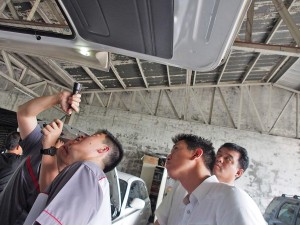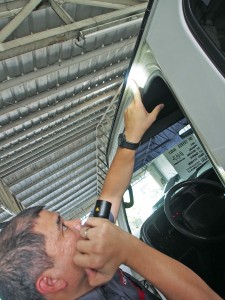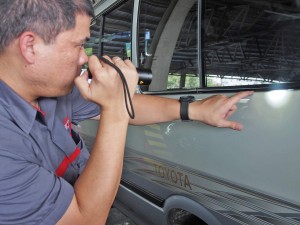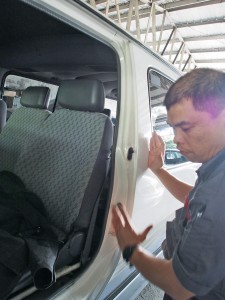Vehicle assessors’ eight guidelines on purchasing second-hand vehicles
It’s relatively easy to decide on what brand-new car to buy. You only have to consider your needs, your wants, and your budget (to buy and properly maintain the vehicle). Where the three intersect, that’s where your brand-spanking new car awaits.
But choosing a used car is a completely different story, one that entails a vastly more complex set of factors.
In buying a second-hand car, you not only have to consider your wants, needs, and financial capacity. First and foremost, you have to know the history of the car you’ve taken a keen interest on.
But how can you, an ordinary motorist with just the barest of skills in car maintenance and troubleshooting, ascertain the true history of a used car? Used car dealers will do what they have to do to make that sale—including making cosmetic touches here and there to take your attention away from underlying structural or functional damages or weaknesses.
A car that looks smooth and clean on the outside should, as a matter of principle, work just as well on the inside, right? Unfortunately, this isn’t always the case in the second-hand vehicle business. There’s that fine line that sellers and buyers share, and you, as the buyer, must possess some forensic and investigative skills not unlike those of the lead characters of the hit TV series “CSI” to be able to uncover that line and be able to strike a deal that leaves both you and the seller wearing that winning smile in the end.
Such skills are the tools of the trade of professional vehicle assessors. Inquirer Motoring got to pick the brains of one of the rare “next-level” assessors, Peter B. Robosa. Robosa is currently in charge of the sales training section of the customer relations department of Toyota Motor Philippines.
Prior to the introduction of the Toyota Certified Pre-Owned Vehicles Program (TCPOV), Robosa, along with three other assessors, underwent an intensive 8-week training under Japanese vehicle assessment expert Kenji Utsunomiya. Today, an integral part of Robosa mission is to cascade his knowledge and expertise to other Toyota dealers that would adopt the TCPOV.
Inquirer Motoring went with Robosa and his student-trainees (from various dealerships) as he inspected a couple of used cars being sold in the vicinity of Makati and Mandaluyong.
During these inspections, Inquirer Motoring noticed eight patterns of checking:
1.) Pillars were the first to be looked into. Robosa said he was looking and feeling for tell-tale signs of structural damage, or if the structural integrity had been compromised. The pillars section is part of his 203-point frame inspection check.
“This is perhaps the most important criteria in determining the overall quality of the used car. This is how we will determine if the vehicle has no damage, or if it is an ‘accident car’ (the term used for vehicles with frame damage),” stressed Robosa.
Professionally trained vehicle assessors like Robosa can identify if a vehicle has a damaged frame, and even determine (the damages) in three levels (light, medium and heavy).
“As to the clues, just by looking outside the vehicle you may already be given a hint if a vehicle may have frame damage. Determining the level of damage, however, needs specialized assessment training,” he said.
“One should also pay careful attention to replaced parts in front of the vehicle, this may be a sign of damage to frame. Brand-new headlights in an old vehicle may mean something,” he added.
2.) Interior and exterior. After checking the frame, Robosa felt the vehicle interior’s ceiling more often than any other part of the interior. He explained, “poor vehicle interior quality will also affect the overall quality of a used car.”
Robosa explained that for the TCPOV assessors, touching is the primary method to determine if an exterior panel had been replaced and/or repaired or repainted.
“Unlike the conventional form of evaluation wherein used car buyers use the katok method (knocking) to determine if a panel has been repainted or not, Toyota assessors use visual and feel (touch) to identify such repairs.”
3.) High and low mileage. Robosa then checked the vehicles’ trip meters and odometers. As much as possible, he stressed, avoid vehicles with high mileage, and be particularly wary of vehicles that have logged in more than 120,000 km. The vehicles’ age is also seriously factored in, where the magic number here is seven, meaning, at the age of 7 and older (the age starts after the year of first registration), the vehicle’s age is already a cause for concern.
Old vehicles with a surprisingly low mileage, meanwhile, can be a sign of a tampered odometer. But there are exceptions. “Check the interior, if it looks overused but the mileage is low, then that is quite suspicious,” Robosa advised.
4.) Robosa then circled the vehicles, and looked at the exterior panels once more. Poorly repaired exterior panels greatly decrease their value. Avoid buying such cars, he said.
5.) Then Robosa went down and peered under the car. Look out for leaks in the engine bay and underneath the vehicle, he noted.
6.) Then it was time to start the engines and take the vehicle out for a short drive. At this stage, Robosa instructed, listen for unusual engine and underchassis noises, and be on the lookout for malfunctioning electrical equipment.
7.) Document checks were next. Robosa said buyers should pay special attention to the vehicle’s documentation history. Any questionable papers should be verified (the information on the Certificate of Registration and Official Receipt should match the information on the actual vehicle). Vehicles being sold in Metro Manila but was registered in distant provinces should also be verified. Make sure the frame and engine numbers are not tampered with.
8.) Flood victim? One most undesirable long-term aftermath of the nightmarish Tropical Storm “Ondoy” in 2009 has been the proliferation of flooded vehicles in the used car market. Such flooded vehicles—not only from Ondoy but from an increasing number of superstorms of late—are potential drains of future owners’ finances.
Robosa admitted that flooded vehicles are sometimes difficult to identify as they may have been repaired extensively by the owner or dealer.
Robosa did reveal three tell-tale signs of a flood-submerged vehicle: odor, mud/molds and rust. “Look for the evidences in hard-to-clean areas. A thoroughly cleaned flooded vehicle will still leave clues. You might see rust on the bottom of the seats (a replaced seat may be another clue); traces of mud on the far end of the seatbelts; extensive rust underneath the dashboard panel (viewed from inside the vehicle) and other hard-to-reach areas where mud/molds can be found.”
The TCPOV program’s 203-point check system is used to determine the overall quality of a used car versus a defined standard vehicle condition. The four vehicle areas that undergo this inspection are the frame, interior, exterior and engine/systems.
An iPhone application, which Robosa used during his inspection routines, is exclusive to the TCPOV program. He said that this application is a first in the Philippines, and is used to provide an accurate evaluation of used cars. It is now also being used in China, Thailand and India for the Toyota Used Car business.




